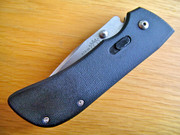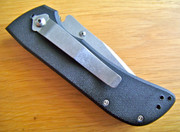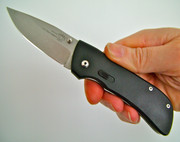My latest find, a Round Eye Knife and Tool (REKAT) Pioneer II from around the year 2000.







Specs:
Length open: 18,7 cm
Length closed: 11,5 cm
Blade length: 7,7 cm
Blade thickness: 3,09 mm
Steel: ATS34 stainless
Handle material: G10 on hardened steel liners
Locktype: Rolling Lock (hardened 440C steel)
Although i find the story a bit hard to believe, American knifemaker Warren Thomas once did some testing with a Pioneer model:
"At the 1998 Las Vegas Classic I acquired four REKAT Pioneers on a trade with Bob Taylor, as i was very curious to see if their claims of lock strength were blown out of proportion.
Sunday night at the motel I decided to test the Swept Point version.
I took my boot and hammered the knife into the door, a standard steel motel door (hope the motel manager isn't reading this) and hung my weight (225 pounds) off the handle against the lock.
I did manage to start slicing the door with the blade with no effect on the lock, that was impressive in itself.
When I returned home I took the same Swept Point into the back yard and stuck the blade into the cloths line T bar.
I did pull ups off the handle and bounced my weight on the knife over six times still no effect.
Bouncing up and down should have done something.
While throwing isn't scientific I then threw the knife hard about sixty times into a plywood garage door sticking it 75% of the time, and one of the screws in the handle stripped out sometime during this.
The knife functioned fine still I figured it was time to get serious.
I taped the handle into a piece of thin wall pipe three feet long and struck the back of the knife at the tip six times against the concrete curb as hard as I could, i did chip concrete and bend the pipe with no effect into the lock.
This was getting frustrating I then got a welding glove and duct taped a piece of micarta to the back of the glove in case the lock failed.
I proceeded to beat the tip of the knives against the curb as hard as I could, after about thirty hard shots I felt movement and it wasn't as solid of a hit so, I checked the knife, at long last, the knife while being in locked position could be unlocked like a slipjoint.
Unbelievably the knife was as functional as a slipjoint knife.
I have broken fixed blades with less abuse and every factory folder I have owned until this wouldn't have lasted past the motel door.
REKAT has achieved a lock that works off of shear strength.
I sent Josh Burbank the knife and told Josh what I did to it he was also amazed at what it took."
Original Rolling Lock patent: http://www.google.com/patents/US5685079
The original Rekat website is long gone (+/- 2001-2002) but with the Waybackmachine you can still take a peek there:
About this Pioneer II folder: http://web.archive.org/web/20000530100649/http://rekat.com/pioneer.html
About the Rolling Lock: http://web.archive.org/web/20001027053928/http://www.rekat.com/about-rollinglock.html







Specs:
Length open: 18,7 cm
Length closed: 11,5 cm
Blade length: 7,7 cm
Blade thickness: 3,09 mm
Steel: ATS34 stainless
Handle material: G10 on hardened steel liners
Locktype: Rolling Lock (hardened 440C steel)
Although i find the story a bit hard to believe, American knifemaker Warren Thomas once did some testing with a Pioneer model:
"At the 1998 Las Vegas Classic I acquired four REKAT Pioneers on a trade with Bob Taylor, as i was very curious to see if their claims of lock strength were blown out of proportion.
Sunday night at the motel I decided to test the Swept Point version.
I took my boot and hammered the knife into the door, a standard steel motel door (hope the motel manager isn't reading this) and hung my weight (225 pounds) off the handle against the lock.
I did manage to start slicing the door with the blade with no effect on the lock, that was impressive in itself.
When I returned home I took the same Swept Point into the back yard and stuck the blade into the cloths line T bar.
I did pull ups off the handle and bounced my weight on the knife over six times still no effect.
Bouncing up and down should have done something.
While throwing isn't scientific I then threw the knife hard about sixty times into a plywood garage door sticking it 75% of the time, and one of the screws in the handle stripped out sometime during this.
The knife functioned fine still I figured it was time to get serious.
I taped the handle into a piece of thin wall pipe three feet long and struck the back of the knife at the tip six times against the concrete curb as hard as I could, i did chip concrete and bend the pipe with no effect into the lock.
This was getting frustrating I then got a welding glove and duct taped a piece of micarta to the back of the glove in case the lock failed.
I proceeded to beat the tip of the knives against the curb as hard as I could, after about thirty hard shots I felt movement and it wasn't as solid of a hit so, I checked the knife, at long last, the knife while being in locked position could be unlocked like a slipjoint.
Unbelievably the knife was as functional as a slipjoint knife.
I have broken fixed blades with less abuse and every factory folder I have owned until this wouldn't have lasted past the motel door.
REKAT has achieved a lock that works off of shear strength.
I sent Josh Burbank the knife and told Josh what I did to it he was also amazed at what it took."
Original Rolling Lock patent: http://www.google.com/patents/US5685079
The original Rekat website is long gone (+/- 2001-2002) but with the Waybackmachine you can still take a peek there:
About this Pioneer II folder: http://web.archive.org/web/20000530100649/http://rekat.com/pioneer.html
About the Rolling Lock: http://web.archive.org/web/20001027053928/http://www.rekat.com/about-rollinglock.html
Last edited:




